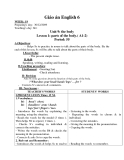
Identify parts of the body
-
Nhằm giúp các thầy cô có tài liệu tham khảo trong quá trình chuẩn bị bài giảng cho unit 9 The body - Tiếng anh 6, giúp học sinh dễ nắm được nội dung của bài. Vì thế chúng tôi xin giới thiệu đến các bạn bộ sưu tập bài giảng unit 9 The body với thiết kế đẹp, hấp dẫn và nội dung đặc sắc giúp bạn thận lợi hơn trong quá trình chuẩn bị bài giảng. Hy vọng với unit 9 The body quý thầy cô có thể giúp học sinh nắm được cách mô tả một số bộ phận cơ thể người.
 21p
21p  diepdiep99
diepdiep99
 21-10-2013
21-10-2013
 312
312
 51
51
 Download
Download
-
Học sinh biết cách sử dụng các từ vựng tiếng anh, cấu trúc câu để mô tả khuôn mặt, cơ thể người. Giáo án điện tử về unit 9 The body - Tiếng anh lớp 6 thích hợp cho quý thầy cô tham khảo soạn giáo án.
 15p
15p  vanbao_04
vanbao_04
 21-10-2013
21-10-2013
 282
282
 46
46
 Download
Download
CHỦ ĐỀ BẠN MUỐN TÌM















